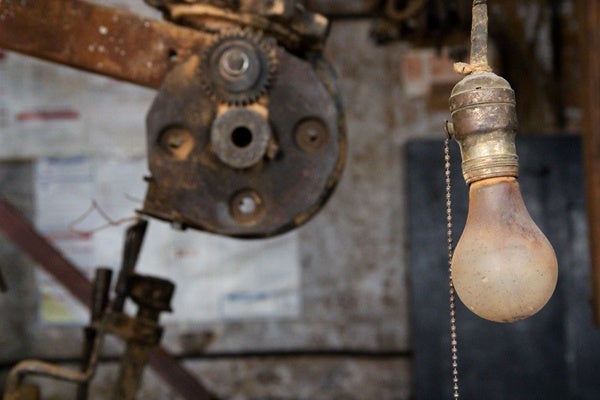Hidden City reveals Philadelphia wood shop frozen in time
Tucked among the art galleries and boutiques on 2nd Street in Philadelphia’s Old City is a boarded-up building, held upright by iron scaffolding. The John Grass Woodturning shop, which closed in 2003, was essentially unchanged since its 19th century origins.
It is one of the forgotten industrial treasures that animate Hidden City, an organization showcasing such urban wonders on a website, and now during its Hidden City Festival.
Unlike modern woodshop machines that each have their own motor, the drill presses, lathes, and saws of the John Grass Woodturning Shop were all powered by a single shaft overhead, which is itself powered by a single, massive motor in the basement — steam-powered at first, then one of Grass’ descendents converted to an electric one.
“There was no additional noise,” said Albert LeCoff, driector of the Center for Art in Wood, with its own woodturning operation a block away. “All you heard was the flapping of the belt. There was a radio on and people were talking — you could talk. It was a very quiet shop and very efficient shop.”
Woodturning is the practice of locking a long piece of wood between two motorized spindles, which rotates the wood very quickly. An operator carves into the spinning wood, creating table legs, balusters, bowling pins, wooden bowls, finials and baseball bats. Many local churches had collection plates made at John Grass, and policemen would come in to have hardwood batons made.
“The billy club that allegedly [former Philadelphia mayor] Frank Rizzo aways carried was probably made here,” said LeCoff.
The last owner of the shop, Lou Bower, walked away in 2003. He couldn’t keep working due to an injury and his sons did not want to get into the business. Seizing opportunity, LeCoff stepped in with a proposal that the building be preserved as a remnant of Philadelphia’s industrial history. The local carpenter’s union bought the building and all its contents with intentions to make a living history museum. Aside from shoring up the walls and roof, that plan has not moved forwad.
Everything stayed where it was left 10 years ago. The beat-up shop radio with a bent antenna is still propped on a stool. A week before the Hidden City Festival, members of the carpenter’s union prepared for visitors by cleaning out some trash, but 50 years of sawdust still coats everything. There are old accounting ledgers still in the front office.
“We found that by doing temporary, low-barrier way to get things up and running and people into a space — not in a permanent way, just getting people into space — gets dialogues happening,” said festival director Lee Tusman. “People come out of the woodwork, literally here, and we find there’s longer-term continuity.”
The aim of the second iteration of Hidden City (the first was in 2010) is to generate stewardship for overlooked historical sites. Through crowdsourcing volunteers online, and programming events onsite, Tusman hopes places like John Grass Woodturning will strike a chord with the public, and help revive dormant plans.
“There’s a new generation, what we call the ‘maker community,'” said Tusman. “You have things like NextFab and Hive76 and The Hacktory. There’s a new, younger generation of people of small-scale manufacturing and experimentation, that would be interested in knowing this history but don’t have access to it.”
Tusman and LeCoff would like to see the old workshop humming again, with part of the three-story building available to woodturners for small-run projects and part preserved as an historical site.
WHYY is your source for fact-based, in-depth journalism and information. As a nonprofit organization, we rely on financial support from readers like you. Please give today.












